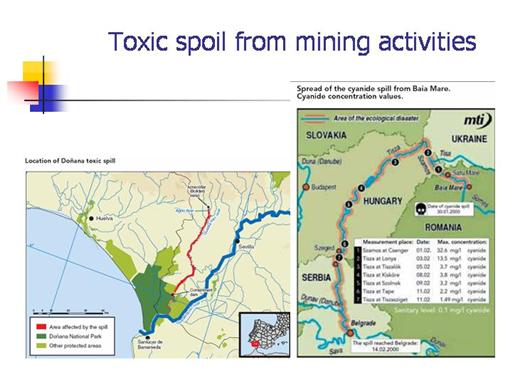| front |1 |2 |3 |4 |5 |6 |7 |8 |9 |10 |11 |12 |13 |14 |15 |16 |17 |18 |19 |20 |21 |22 |23 |24 |25 |26 |27 |28 |29 |30 |31 |32 |33 |34 |review |
 |
The two major mining-related events
between 1998 and 2002 highlighted
the very severe environmental impacts and huge economic costs.
The accidents occurred near the Doñana
National Park in south-western Spain in April 1998 and in the Baia Mare
region of northern Romania in January 2000.
On 25 April 1998, the dam storing
waste water from mining operations by a Spanish subsidiary of the
Canadian-Swedish Boliden company in Aznalcóllar breached and spilled
around four million cubic metres of acid waters, as well as two million
cubic metres of toxic mud, into the fluvial system of the Agrio and
Guadiamar rivers.
The toxic flood inundated about 5 000
hectares of land near the watercourses (60 % crops and fields, 40 %
pastures and river vegetation). While the mud accumulated in the first
40 km of the river, the acid water flowed 20 km further downstream. It
was stopped by an emergency containment dam just before entering the
National Park and then redirected to the Guadalquivir river. However, 98
hectares of the National Park were directly affected (0.19 % of its
total area).
On 30 January 2000, almost 100 000 m3
of water polluted with high cyanide concentrations spilled out through a
25 metre break in the dam of a waste (or ‘tailings’) sedimentation pond
at the mining company SC AURUL SA in the region of Baia Mare in
north-western Romania. It was the beginning of one of Europe’s worst
transboundary pollution incidents in recent years. The contaminated
water flowed into an adjoining area of
around 20 hectares of agricultural
land. Through drainage systems it reached the Lapus River and from there
the Somes/Szamos, Tisza and Danube rivers before reaching the Black Sea.
|